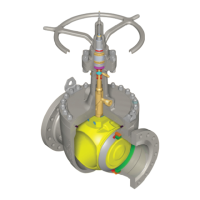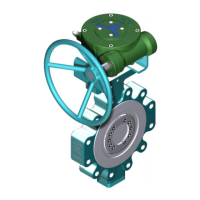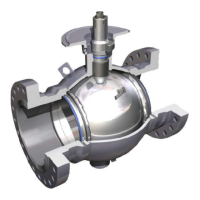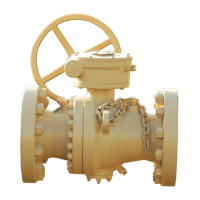ENGINEERED & PROCESS VALVES
07/2011 / IOM-GEN-TWIN-03
5
Installation, Operation and Maintenance Manual
Valve figure No.
C411; C811; C911;
8811; C1611; C1500
C421; C821; C921;
8821; C1621; C1521
C441; C841; C941;
C1641; C1541
C851; C1651;
C1551
Comments
ASME Class 150 300 600 900
Shell Test Pressure
(Valve Open)
(pisg)
(kg/cm2)
500
35
1200
85
2250
158
3350
235
No leakage permitted
Seat Test Pressure (Valve Closed) (psig)
(kg/cm2)
300
21
800
56
1600
113
2400
168
Test upstream &
downstream seats. No
leakage permitted
Supplimentary (API 598) Air Seat Test
Pressure (Vavle Closed)
(psig)
(kg/cm2)
80
6
80
6
80
6
80
6
Test upstream &
downstream seats. No
leakage permitted
Pressure Test
Twin Seal valves can be hydrostatically pressure-tested after installation, to full API 6D limits per Table 3 below.
Table 3
The Twin Seal valve is a non-lubricated, resilient seal, plug-
type valve which has a mechanical means of freeing the plug
before it is rotated from the closed to the open position.
In opening the valve, the plug is raised, thus retracting the
seating segments or slips through their tapered dovetail
connections. Only after the slips are fully retracted perpen-
dicularly from the body seat is the plug rotated to the open
position.
Conversely, in closing the valve, the plug and slips are
rotated freely, with no seal-to-body contact until the slips
are positioned over the ports. Then the plug is driven down
between the slips and the tapered surfaces wedge out the
slips for a positive upstream as well as downstream shut-off.
For maximum upstream sealing, do not back off the hand
wheel. Warning: Do not over torque by using cheater bars.
The small Twin Seal valves are handwheel operated, and
require up to 3 turns to open or close. Up to 2 3/4 turns
expand or retract the slips, while 1/4 turn rotates the plug.
Large valves operate in a similar manner, except that they
have enclosed weather-proof worm gearing.
At the top of the valve, a position indicator flag shows the
exact plug position. It appears in line with the flow when
the valve is open, and perpendicular to the flow when the
valve is closed.
OPERATION
Since Twin Seal valves hold bubble-tight, for ease of
opening in liquid service, it is important to prevent trapped
body pressure from exceeding the working pressure of the
valve. Therefore, a relief system is required to prevent pres-
sure buildup in the body cavity.
A
B
C
D
